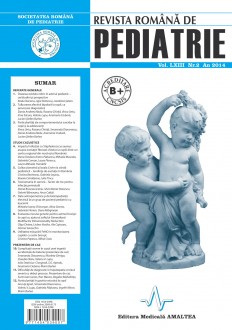SELECT ISSUE

Indexed

| |

|
|
|
| |
|
|
|

|
|
|
|
|
|
|
HIGHLIGHTS
National Awards “Science and Research”
NEW! RJP has announced the annually National Award for "Science and Research" for the best scientific articles published throughout the year in the official journal.
Read the Recommendations for the Conduct, Reporting, Editing, and Publication of Scholarly work in Medical Journals.
The published medical research literature is a global public good. Medical journal editors have a social responsibility to promote global health by publishing, whenever possible, research that furthers health worldwide.
DRUG ADDICTION DURING PREGNANCY – RISK FACTOR FOR PERINATAL INFECTIONS
Doina Broscauncianu, Silvia Maria Stoicescu, Gabriel Banceanu and Anca Cabat
ABSTRACT
Introduction. Neonatal infections are a major causes of neonatal morbidity and mortality. Pregnancy complicated by illicit drug abuse is a risk for perinatal infection.
Objective. To assess the incidence of early-onset neonatal sepsis (the first 7 days of life) in newborns from high-risk pregnancies for perinatal infections: the ones affected by drug abuse, without medical assistance versus clinical and fully investigated pregnancies.
Material and methods. Retrospective study on newborns from “IOMC – Emergency Clinical Hospital of Obstetrics and Gynaecology Gh Polizu”, Bucharest, sorted in two separate groups: one of 25 newborns, from 2005 to 2012, coming from uninvestigated pregnancies in women with illicit drug dependencies and another of 50 newborns from properly managed pregnancies from the clinical and anamnestic point of view, but with known risk factors for perinatal infections. The data has been statistically analysed (correlation tests: Student T, Fisher exact, chi-square)
Results. The incidence of newborns from pregnancies affected by drug abuse was 0,09% in all 28489 newborns, the highest percentage of 0,2% being recorded in 2011. Statistically significant differences between the two groups of newborns with risk factors for perinatal infections (emerged from uninvestigated pregnancies with drug abuse and respectively from investigated pregnancies) were: the age of the mothers – lower in drug addicted mothers (p_value 0,0002), the percentage of congenital infections (p_value 0,00003; OR 0,03; 95%CI) and respectively the mean length of hospital stay-days (p_value0,0180) higher in dug addicted mothers. On the other hand: the delivery by cesarean section (p_value 0,0010), urogenital colonisation (p_value 0,0016) were more frequent in newborns from investigated pregnancies. A percent of 22 of all investigated women were positive for Group B Streptococcus and the most frequent type was I b type. The share of perinatal infections among neonatal morbidity was 33% for the newborns from drug addicted mothers and 27% for the newborns from investigated mothers. The incidence of neonatal infections was 52% for the newborns from drug addicted mothers (a risk of 1 in 1,9 cases) and 18% for the newborns from investigated mothers (a risk of 1 in 5,5 cases)
Conclusions. Drug addiction during pregnancy represents a high risk factor for perinatal infections due to sexual and blood transmitted diseases associated with lack of hygiene, precarious nutrition and low immunological status and leads to high medical and social costs. The correct medical management of pregnancies, through early diagnosis and treatment of neonatal infections may lower the incidence and the consequences of perinatal infections.
Keywords: risk factors, perinatal infection, fallow up of pregnancy, maternal drug abuse
